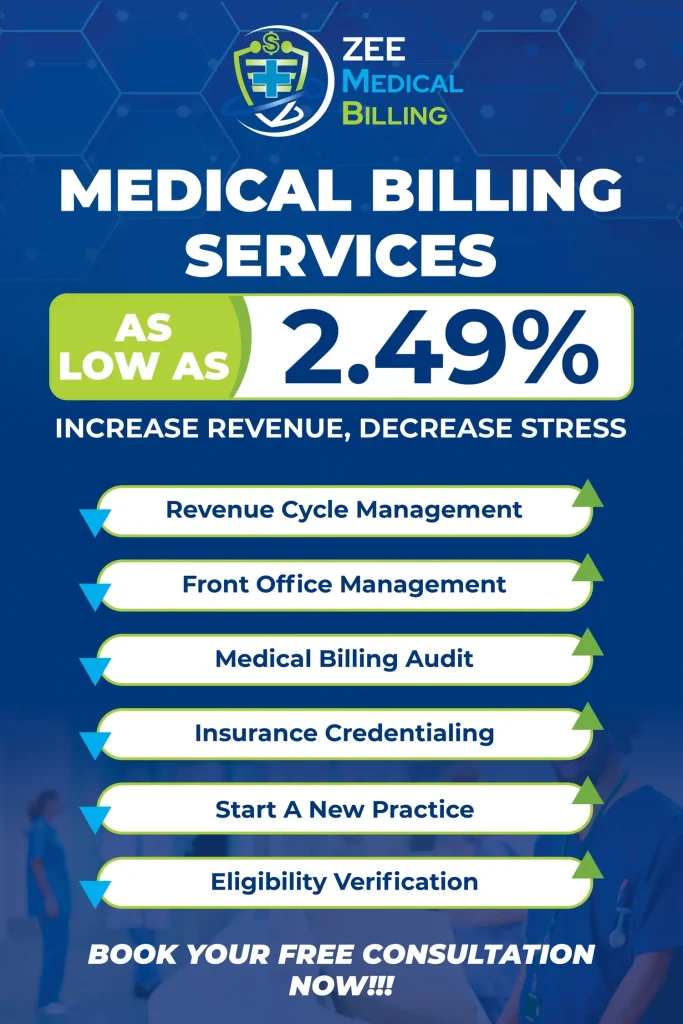In the complex world of medical billing, correct coding is essential for accurate reimbursement. One commonly misunderstood code is Modifier 59. If used correctly, it can ensure proper payment for services. However, misuse can lead to denials or audits.
In this blog, we’ll explain the definition of Modifier 59, its purpose, when to use it, and how it compares to other modifiers like XU. Whether you’re a billing specialist or provider or just want to understand the basics, this guide is for you.
What Is Modifier 59?
Modifier 59 is a CPT modifier used in medical billing. It shows that two or more procedures done on the same day are different and separate.
In simple terms, it tells the payer:
“Yes, these services might normally be bundled, but in this case, they were separate and should be paid individually.”
Read More: Modifier 25 in Medical Billing: Simple Guide & Use
Modifier 59 Description (Simple and Clear)
Here’s the Mod 59 description in plain English:
“Providers use Modifier 59 to show procedures or services that they do not usually report together.” However, they are appropriate in certain situations.”
For example, if you do two procedures on different body parts or at different times on the same day, you might need Modifier 59.
Why Is Modifier 59 Important in Medical Billing?
Correct use of Modifier 59 in medical billing ensures that providers receive fair reimbursement for all services rendered. Insurance companies often bundle similar procedures into a single payment unless you clarify that they are distinct.
Incorrect use can lead to:
- Claim denials
- Delayed payments
- Potential audits
Understanding when to use Modifier 59 helps protect revenue and maintain compliance.
When to Use Modifier 59?
Use Modifier 59 when:
- Different Session or Encounter: Procedures are performed at different times on the same day.
- Different Body Areas: Services were performed on separate anatomical sites.
- Different Procedure or Surgery: Even if codes are normally bundled, in your case, they were distinct.
- Separate Incision or Injury: Especially relevant in surgical settings.
Real-World Example
Let’s say a doctor removes a skin lesion from the arm and also performs a biopsy on the leg during the same visit. These are two distinct procedures. In this case, the coder adds Modifier 59 to the second code to indicate it should not be bundled.
Modifier 59 CPT Code Guidelines
When using CPT code Modifier 59, follow these best practices:
- Never use it just to bypass bundling rules. It must reflect a real clinical distinction.
- Apply to the correct CPT code. Usually, it’s added to the lesser-valued procedure.
- Use documentation to support the claim. Payers can ask for proof.
- Check payer-specific rules. Some insurers may require X modifiers instead.
Modifier 59 vs. XU Modifier: What’s the Difference?
A common question is the difference between XU and 59 Modifier. Both indicate distinct services, but XU is more specific.
XU Modifier (Unusual Non-Overlapping Service)
Use XU when two services are the same but don’t overlap in how or where they are performed. For example:
- Using two different technologies to perform procedures that would normally overlap.
When to Use Modifier 59 Instead of XU?
Use Modifier 59 only if a more specific modifier (like XE, XS, XP, or XU) doesn’t apply.
How to Apply Modifier 59 Correctly?
Here’s a quick checklist:
- Review NCCI (National Correct Coding Initiative) edits
- Identify if procedures are bundled
- Check for separate locations, sessions, or procedures
- Attach Modifier 59 to the correct CPT code
- Ensure documentation supports the use
Common Mistakes to Avoid
- Using Modifier 59 just to get a claim paid
- Adding it to every procedure “just in case”
- Using it without documentation to support the separation
- Applying it when a more appropriate modifier (like XU) exists
Misuse of Modifier 59 can raise red flags and even result in payer audits or penalties.
Read More: Skin Tag ICD-10 Codes and CPT Guide for Easy Billing
Scenarios Where Modifier 59 May Be Appropriate
Here are a few billing scenarios where Modifier 59 might be valid:
| Scenario | Is Modifier 59 Needed? |
| Colonoscopy and biopsy at different sites | ✅ Yes |
| Skin excision and closure on different limbs | ✅ Yes |
| X-ray of both hand and elbow | ❌ No (these are typically not bundled) |
| EKG and pulse oximetry performed together | ❌ No (often bundled unless separate reason) |
| Two procedures in one surgical site | ❌ No (not distinct unless clear documentation supports it) |
FAQs
1. What does Modifier 59 mean in billing?
It informs the payer that someone performed two services separately. Providers usually bundle these services, and customers should pay for them individually.
2. What is the difference between Modifier 59 and Modifier 25?
Providers use Modifier 59 for procedures. Modifier 25 is for evaluation and management (E/M) services done on the same day as a procedure.
3. Can I use Modifier 59 on any CPT code?
No. Only use it when the codes are in a bundled pair per NCCI edits, and the services are clearly distinct and well documented.
4. Is documentation required when using Modifier 59?
Yes. You need to clearly explain why the procedures were separate. This will help avoid denials and support using the modifier.
5. How do I know when to use Modifier 59 vs. the X-modifiers?
Use X modifiers when they describe the situation more precisely. If none of them apply, use Modifier 59 as a general indicator of a separate service.
Conclusion
Modifier 59 is a valuable tool in medical billing—but only when used correctly. It clarifies billing scenarios where you performed multiple procedures separately and ensures your practice receives proper reimbursement.
However, misuse can lead to claim denials, lost revenue, or even compliance issues. Always follow the CPT guidelines, review NCCI edits, and keep strong documentation.
Knowing when to use Modifier 59 helps avoid mistakes. It also makes billing easier and speeds up payments.
✅ Next Step: Review your commonly used codes and ensure you apply Modifier 59 correctly. Train your billing team to use it only when truly appropriate.
By doing so, you’ll improve compliance and keep your revenue cycle strong.
Need Expert Medical Billing Services?
Zee Medical Billing provides professional billing solutions tailored to healthcare providers across the United States. In addition to offering top-tier support from our main office, we proudly serve clients in Illinois, Indiana, California, Kentucky, New York, Washington, Georgia, Alabama, South Carolina, Texas, Pennsylvania, Ohio, New Hampshire, Nevada, Massachusetts, Hawaii, Arizona, and Colorado! Whether you’re looking to streamline your revenue cycle or improve claims accuracy, you can reach out to us to learn more about how we can support your practice.









